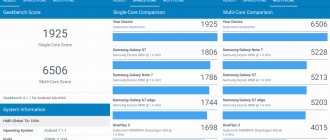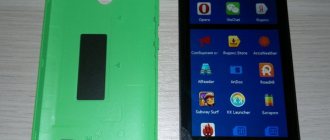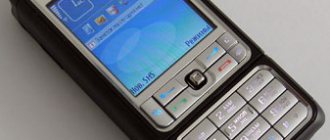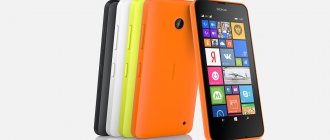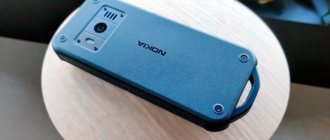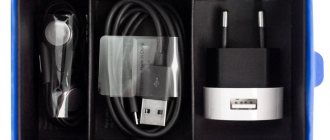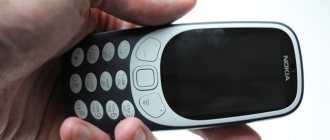Nokia 5.1 Plus specifications:
- Screen: 5.8 inches, IPS, 1520*720 pixels, 19:9, 2.5D;
- Processor: MediaTek Helio P60 (8×1.8 GHz), Mali-G72 graphics;
- Permanent memory: 32 GB + MicroSD up to 400 GB;
- RAM: 3 GB;
- Main camera: dual 13 MP (f/2.0) + 5 MP, FHD video recording
- Front camera: dual 8 MP (f/2.2), HD video
- Battery: non-removable 3060 mAh;
- Additionally: 4G, Dual Nano-SIM, Bluetooth2, Wi-Fi 802.11ac, GPS/GLONASS, USB Type-C, 3.5 mm jack, fingerprint scanner;
- OS: Android1 8.1 Oreo;
- Dimensions: 149.51 x 71.98 x 8.096 mm, weight - 160 g.
The release date of Nokia 5.1 Plus in Russia is September 14, you can buy a smartphone at a price of 14,990 rubles. The gadget is available in black, white and blue body colors.
Nokia X5 specifications in detail
Platform
Chipset Mediatek Helio P60 (MT6771) Octa core CPU 4 x ARM Cortex-A73 @ 2.00 GHz 4 x ARM Cortex-A53 @ 2.00 GHz 64-bit Yes GPU ARM Mali-G72 MP3 @ 800 MHz NPU Yes Process technology 12 nm HPM
Memory
RAM 3 Gb - LPDDR4x @ 1800 MHz (Dual Channel) Built-in storage 32 Gb - UFS 2.1 Memory expansion Yes Memory card types microSD, microSDHC, microSDXC Maximum capacity 256 Gb Dedicated slot No
Screen
Resolution 720 x 1520 (Wide HD+) Aspect ratio 9:19 Matrix type IPS Diagonal 5.86″ Area ~85.7 cm2 Fill percentage ~79.6% (of the total front surface area) Pixel density ~287 ppi Security Yes
Connection
Communication standards GSM, CDMA, UMTS, TD-SCDMA, LTE 2G GSM 850/900/1800/1900 MHz CDMA BC0 3G UMTS B1 2100 MHz, B2 1900 MHz, B5 850 MHz, B8 900 MHz 3G TD-SCDMA B34/B39 4G LTE FDD B1 2100 MHz, FDD B3 1800 MHz, FDD B5 850 MHz, FDD B8 900 MHz, TDD B34 2100 MHz, TDD B38 2600 MHz, TDD B39 1900 MHz, TDD B40 2300 MHz, TDD B41 2500 MHz LTE support Yes LTE categories Category-7 DL / Category-13 UL LTE Speed Up to 300 Mbps in download mode, up to 150 Mbps in upload mode LTE device categories indicate the maximum speed at which it can send and receive data on 4G LTE networks due to carrier aggregation. Number of SIM cards 2 Type of SIM cards Nano SIM
Cameras
Main camera
Type Dual Resolution 13.0 Mp + 5.0 Mp Autofocus Yes Aperture No data Features Face Beauty, Face Detection LED Flash
Front-camera
Resolution 8.0 MP Aperture No data
Interfaces
WiFi IEEE 802.11 a/b/g/n/ac, 2.4 GHz + 5 GHz, Wi-Fi Direct, DLNA, Wi-Fi access point mode is a technology for building wireless local networks based on the IEEE 802.11 family of standards. Supported by all modern smartphones and many mobile phones. Bluetooth v4.2 Bluetooth is a universal wireless interface for exchanging data between various types of devices at close range. Can be used for file transfer, audio streaming, network connection, printing and other purposes. The newer the version, the greater the speed and number of supported profiles. Navigation GPS, A-GPS, Glonass, Beidou For at least 10 years, smartphones have supported the geolocation function using data from satellite navigation systems. At the moment, these are the American-developed GPS, the Russian GLONASS, the Chinese BeiDou and the European GALILEO. As a rule, smartphones support the first two and optionally the rest. NFC No The built-in NFC module of a smartphone is mainly used for contactless payment in applications like Google Pay and Samsung Pay. Can also be used to read data from contactless cards, transfer files, etc. Read more here. Infrared port No Some smartphones have a built-in IR port. In the past, it was used to synchronize data both between two mobile phones and between a phone and a PC. However, now, due to its low speed, the infrared port is used mainly to control external devices in remote control mode. FM radio No Built-in radio receiver that allows you to listen to radio stations operating in the FM range. In most cases, it only works when headphones are connected, since the wire is used as a communication antenna. However, there are devices with a built-in antenna. 3.5 mm audio Yes Standard audio jack for connecting wired headsets and headphones. Starting in 2020, some smartphone manufacturers, following Apple, began to abandon it. In this case, to connect regular headphones, you need a special adapter for Lightning/USB Type-C. USB USB Type-C, On-The-Go The type of USB connector installed in the smartphone and the capabilities it supports.
Sensors and biometrics
Sensors Accelerometer, Electronic compass, Gravity sensor, Gyroscope Fingerprint scanner Yes Scanner location On the back of the case Scanner reaction time No data Face scanner (Face ID) No Iris scanner (IRIS) No
Power supply
Battery capacity 3060 mAh Battery type Li-ion Removable battery No Fast charging Yes Wireless charging No
Software
Operating system Android 8.1 Oreo Shell No Over-the-air (OTA) update Yes Sending messages SMS, MMS, Email, Push Email, IM Internet browser HTML5, CSS, JavaScript Audio formats AAC, Midi, MP3 Video formats 3GP, MP4 Graphic formats BMP, GIF, JPEG, JPG, PNG Voice assistant Google Assistant
Physical parameters
Dimensions 149.5 x 72.0 x 8.1 mm Weight 160 g Package dimensions 198.0 x 110.0 x 46.0 mm Package weight 400 g Protection class No Colors Black, Blue
Performance
Geekbench No AnTuTu data 130000 points Nokia X5 performance rating according to the popular AnTuTu benchmark.
Average data are shown. PassMark No data Important note : unfortunately, we cannot guarantee 100% accuracy of all data presented on this page, but we are constantly working in this direction. If you notice an error in the device settings, we will be very grateful if you report it in the comments.
Top
Design and ergonomics
The delivery package with the smartphone includes a 10 W charger and a USB Type-C cable, a wired headset and a paper clip. You don’t have to worry about the need to buy fast charging, since the hero of our review does not support it.
The Nokia 5.1 Plus looks like a typical 2020 smartphone, with thin bezels around the screen and a massive unibrow. Such gigantic dimensions of the cutout remained a mystery to us, since all the functional elements (camera and sensors) are located to the left of the speaker grille, and the area to the right of it is not occupied by anything. In fact, the unibrow here is twice as large as it should be, and it does not bring any advantages; on the contrary, there is less free space for notifications.
There is a small “chin” under the display, the frame is normal in thickness for a budget smartphone, but the manufacturer decided to ruin the clean look of the gadget and stuck the Nokia brand name in the center. Logo on the front in 2020? Are you seriously?
The screen is covered with tempered glass, the manufacturer of which Nokia does not name. The glass has a 2.5D curve and smoothly flows along the edges into the side frame of the case, which is made of aluminum. The metal is painted with a glossy black paint, which is likely to wear out intensively, so the protective case is a must-have for anyone who wants to preserve the cosmetic appearance of the device.
The back of the case is made of the same tempered glass as the front panel. On top there is a module with a dual camera and LED flash, below it is a fingerprint scanner. The scanner platform is exactly where it is needed, when the smartphone is in your hands, the index finger automatically hits it, and the scanner itself works very quickly and accurately.
Glass surfaces quickly become stained, but thanks to the presence of good oleophobic properties, they are easily wiped off from fingerprints.
There are absolutely no complaints about the assembly of Nokia 5.1 Plus; the device is made of very high quality.
The only thing that raises questions is the eye-catching manufacturer’s logo and the swollen unibrow, but otherwise the smartphone looks much more expensive than its price. In addition, there is a USB-C port, which is very rare in affordable devices.
Nokia X5 – 150 bucks will do
Warning
: Use of undefined constant type — assumed 'type' (this will throw an Error in a future version of PHP) in
/var/www/u0260287/data/www/superg.ru/wp-content/themes/smart-mag/ functions.php
on line
1493 Warning
: Use of undefined constant url — assumed 'url' (this will throw an Error in a future version of PHP) in
/var/www/u0260287/data/www/superg.ru/wp-content /themes/smart-mag/functions.php
on line
1498 Warning
: Use of undefined constant type — assumed 'type' (this will throw an Error in a future version of PHP) in
/var/www/u0260287/data/www/ superg.ru/wp-content/themes/smart-mag/functions.php
on line
1501 Warning
: Use of undefined constant color — assumed 'color' (this will throw an Error in a future version of PHP) in
/var/www /u0260287/data/www/superg.ru/wp-content/themes/smart-mag/functions.php
on line
1501 Warning
: Use of undefined constant type — assumed 'type' (this will throw an Error in a future version of PHP) in
/var/www/u0260287/data/www/superg.ru/wp-content/themes/smart-mag/functions.php
on line
1493 Warning
: Use of undefined constant url — assumed 'url' (this will throw an Error in a future version of PHP) in
/var/www/u0260287/data/www/superg.ru/wp-content/themes/smart-mag/functions.php
on line
1498 Warning
: Use of undefined constant type — assumed 'type' (this will throw an Error in a future version of PHP) in
/var/www/u0260287/data/www/superg.ru/wp-content/themes/smart-mag/functions.php
on line
1501 Warning
: Use of undefined constant color — assumed 'color' (this will throw an Error in a future version of PHP) in
/var/www/u0260287/data/www/superg.ru/wp-content/themes/smart-mag/functions .php
on line
1501 Warning
: Use of undefined constant type — assumed 'type' (this will throw an Error in a future version of PHP) in
/var/www/u0260287/data/www/superg.ru/wp-content/ themes/smart-mag/functions.php
on line
1493
Today, HMD Global showed the world a new device – Nokia X5 or Nokia 5.1 Plus, if the smartphone reaches us. Of course, Nokia is not what it used to be, but it fulfills the minimum program in creating smartphones. We look and evaluate the new device.
The design is boring and boring, all previous Nokia models were like this, and all the next ones will most likely be the same. Before us is an uninteresting brick with slightly rounded corners, the back panel of which is as pragmatic as possible: camera lenses, a fingerprint scanner and a logo. In front there is a visor (damn it) and a too wide lower frame, the dimensions of which in no way justify the brand name on it.
The screen itself has a diagonal of 5.86 inches and an aspect ratio of 19:9 - in theory, we can say that the device is almost compact (149 height and 72 width), and it will be convenient to use. By the way, the display is covered with rounded 2.5D glass, the same is located on the back, so the smartphone promises to be tactilely pleasant. If you close your eyes to the overall boring appearance, then the colors themselves are not bad: glossy blue, white and black.
Everything is clear on the outside, what's inside?
The role of the processor is played by the eight-core MediaTek Helio P60 with a maximum power of 2.0 GHz, and you can pair it with 3 or 4 GB of RAM. The option, frankly speaking, is mediocre, but here you need to remember that the device runs on a pure version of Android, without any weighty shells. This means that he is guaranteed speed and performance that is at least above average. The drive is also available in two versions (32/64 GB), and if it’s not enough, it can be expanded.
The batteries here are 3060 mAh, without any fast charging or other tricks - but they should hold a charge well, again, thanks to the “naked” Android. The manufacturer even provides official battery life data: 27 hours of standby time, 17 hours of calls, 19 hours of music, 6 hours of games and 11 hours of video. It sounds really good, but we'll see if it happens in reality.
What about the photo and video capabilities? There are two rear lenses: 13 and 5 megapixels, and absolutely nothing specific is said about them. A little more is known about the front 8-megapixel camera: it supports AI algorithms, blurred backgrounds, and face unlocking of the smartphone using the front lens.
Technical specifications of Nokia X5 ( Nokia 5.1 Plus)
- MediaTek Helio P60 chip (12nm, 4x Cortex-A53 and 4x Cortex-A73 at 2.0 GHz)
- graphics Mali-G72 MP3 800 MHz
- RAM 3/4 GB
- storage 32 / 64 GB
- Micro SD card support up to 256 GB
- 5.86 inches with a resolution of 1520 x 720 pixels (HD+, 18:9, density 287 ppi, 2.5D glass)
- 8 MP front camera (f/2.2, viewing angle 80.4 degrees, face recognition)
- dual rear camera 13 + 5 MP (PDAF, f/2.0)
- battery 3060 mAh
- Android 8 Oreo
- sensors: light, distance, gyroscope, compass, accelerometer, fingerprint scanner
- Connectors: USB Type-C, 3.5 mm audio output
- dimensions: 149.51 x 71.98 x 8.09 mm, 177 grams
Wireless interfaces:
- 2G, 3G, 4G LTE networks (unknown bands)
- format and number of SIM cards are not specified
- Wi-Fi 802.11 (a/b/g/n/ac), Bluetooth 4.2, GPS, GLONASS, Beidou
As for the price, it is offered to buy the Nokia X5 in the younger 3/32 GB configuration for $149 (or 9,300 rubles), and the cost of the 4/64 GB version is currently unknown. Sales have already started in China, but it has not yet been announced when the new product will reach Russian retail.
Nokia Nokia 5.1 Plus Nokia X5
Display
The IPS display diagonal is 5.8 inches, resolution is 1520x720 pixels with an aspect ratio of 19:9. HD resolution is not enough for such a large matrix, and the jagged outlines of icons and fonts, as well as the general looseness of the picture, are noticeable to the naked eye, especially if you pick up the smartphone after an FHD device.
There are also problems with color rendering; the white balance is heavily tilted towards cool blue shades. There is no way to configure the BB in pure Android, but you can slightly correct the situation by constantly turning on the night mode at minimum intensity. The maximum brightness of the matrix is at 412 nits - this is not much; to use the smartphone comfortably in the bright sun, sometimes you have to cover the display with your hand.
Performance
Nokia 5.1 Plus is powered by a MediaTek Helio P60 processor with 3 GB of RAM and 32 GB of storage, supports MicroSD cards up to 400 GB (hybrid slot). The P60 is a fresh and quite powerful eight-core chipset, slightly superior in performance to the Snapdragon 636.
However, Nokia decided to slightly reduce the operating frequencies of the processor (from 2.0 to 1.8 GHz). A compromise is apparently necessary to improve the autonomy of the device. Because of this, the Nokia 5.1 Plus is inferior in synthetics to its Helio P60 counterparts (130 versus 140 thousand points for the Oppo F9 in AnTuTu), but overall the smartphone works well. Interface animations, launching and switching between applications, watching videos - all this happens quickly and smoothly. The low screen resolution allows the gadget to feel confident in games. Projects that require system resources like PUBG and Asphalt 9 can be comfortably played at medium and high graphics settings, while the device practically does not heat up; the body temperature does not rise above 43 degrees after 30 minutes of gaming.
Advantages and disadvantages of the X5 phone
Nokia X5 measures 71.98 mm wide, 149.51 mm long and 8.1 mm thick. With such dimensions it is convenient to operate the device with one hand. In addition, the weight of the device is about 160 g. Even if you operate the device with one hand, its weight is almost not felt.
If we evaluate the overall ease of use of the phone taking into account the size and weight, then there will be no problems with everyday use.
The smartphone is equipped with an 8-core MediaTek Helio P60 (MT6771) processor, which is made on 12 nm. technical process.
The smartphone has 3 GB. RAM, which is quite enough. In very rare cases it will not be enough, but with this amount of RAM, you will rarely have problems.
The device's data storage capacity is 32 GB, and while this is enough for photos, it may not be enough for video shooting and a large number of games.
The phone is compatible with SD cards, so you can easily expand its memory. So you probably don't need to worry about storage capacity.
The X5 has a display diagonal of 5.86 inches. It's quite big. Photos, videos and games will look great on this screen. It is also suitable for productive use, such as creating a business document.
The smartphone has a high-end display and any graphic content you display on it, including videos and games, will be displayed clearly.
The main camera of the phone has 12.98 megapixels and can take high-resolution photos and videos. While you're shooting landscapes or printing high-definition photos, you may want a higher-resolution camera, but most of the time you'll be happy with the camera.
Also, the smartphone has a 7.99 megapixel front camera, which is average for smartphone cameras. This is good enough for taking selfies, but you may not be satisfied with group photos or their print quality.
The Nokia X5 battery capacity is 3060 mAh, which is a relatively large indicator. Compared to other smartphones, the Nokia X5's battery life is good. With this capacity, you won't experience any problems even if you spend time on the Internet or Twitter for a long period of time. Even while playing games or watching videos, you can do so comfortably without worrying about battery life. However, some caution should be exercised when watching movies or playing games for too long.
Camera
The dual main camera consists of a 13 MP sensor with f/2.0 aperture and a 5 MP secondary sensor for determining depth of field. The standard camera application is simple and intuitive, there are HDR, timer, panorama, and portrait modes, but there are no manual settings (shutter speed and ISO).
In daylight, the photos come out quite decent, as for a budget smartphone. The automatic BB almost always copes with its tasks and provides adequate color rendition, detail is also quite good, but in direct proportion to the deterioration of lighting conditions, the pictures become increasingly soapy due to the aggressive operation of the noise reduction. Insufficient dynamic range spoils the picture, as a result of which the shadow areas in the photo usually look too dark. Things are a little better when using the HDR mode.
The portrait mode was not encouraging: the blur looks artificial, and the camera often makes mistakes with the contours of even simple-shaped objects. The front camera is of average quality, there is support for portrait mode.
The smartphone records video in FHD resolution at 30 frames per second. When shooting, you still feel the same lack of dynamic range, but there is optical stabilization, which works very effectively.
Sound
The smartphone has one multimedia speaker, it is located at the bottom end of the case, to the left of the USB-C port. The speaker is indeed very loud, but at maximum volume there is noticeable distortion in the sound; you can comfortably listen to videos and podcasts at a volume of 75-80% of the maximum, which is more than enough.
There is a headphone jack, there is also support for FM radio and support for LDAC, aptX, aptX HD codecs.
Autonomy
The autonomy is provided by a 3060 MAh battery, which can be fully charged in 2 hours using the included 5V/2A adapter; the smartphone does not support fast charging. With continuous video playback at 50% screen brightness with wireless interfaces disabled, the gadget lasted 9 hours - this is a good indicator, which is achieved due to the energy-efficient chipset. The smartphone lasts 4 hours in games, and during normal use it is confidently enough for a day of moderately active use.
Communications and wireless interfaces
The main disappointment associated with the Nokia 5.1 Plus is perhaps the lack of an NFC module in the smartphone. Why the manufacturer decided to abandon it is not clear, since even the regular Nokia 5.1, which costs significantly less, has NFC. On other points, everything is standard, the smartphone supports all network bands necessary for communication, there are no complaints about the quality of signal reception and voice transmission. GPS navigation works well, satellites are found very quickly, the error does not exceed 1 m. There is also OTG support.
Design
Unlike its younger brother Nokia 5.1, the aluminum alloy of the 6000 series in the new product was replaced with glass with a shiny plastic edging around the perimeter. So the appearance of the “plus” gadget turned out to be glamorous and glossy. It is worth noting that due to the thin frames, in terms of the ratio of screen area to the front surface, Nokia 5.1 Plus was ahead (about 6%).
The mirror body is complemented by the metal rim of the rear photo module. The aspect ratio (19:9) of the screen “pulls” the 5.86-inch matrix upward, and the glass with a 2.5D effect does not dig into the palm.
With dimensions of 149.51 × 71.98 × 8.1 mm, Nokia 5.1 Plus weighs about 160 g. There are 3 color options for the body - black, white and indigo, and all these colors are glossy. The glass surface readily collects fingerprints.
As noted above, the front panel of Nokia 5.1 Plus is covered with protective 2.5D glass.
On the rather large “notch” of the screen, there would also be enough space for elements for 3D face recognition, but they only fit a small speaker grille, a front camera, and also light and proximity sensors.
The touch control buttons “Back”, “Home” and “Recent applications” (icons “triangle”, “circle” and “square”) in Nokia 5.1 Plus were made on-screen, and the “chin” under the display was decorated with its Nokia logo.
See also: Features of the new Sony Xperia XZ1 Premium with 4K display
On the right edge of the case there is a thin power/lock button and a volume rocker, which can be distinguished by feeling only by their length.
The left edge was given to a closed slot, where one place in the tray was for the first subscriber identification module (nanoSIM format), and the other is occupied by either a microSD memory expansion card or a second nanoSIM.
Around the USB Type-C (USB 2.0) connector at the bottom end there is space for a decorative grille for a “multimedia” speaker and a hole for a “conversational” microphone.
The upper end has a hole for a second microphone and a 3.5 mm connector for an audio headset.
The glass back panel is also decorated with the Nokia logo.
In its upper part there are vertically located lenses of the main and auxiliary cameras, as well as an LED flash. Just below the rear photo module, space was allocated for a round platform for a fingerprint scanner.
From the inscriptions located at the bottom of the glossy panel you can find out that this model was developed by the Finnish company HMD Global and manufactured in China. At the same time, the gadget itself was released as part of the Android One program.
The glass body of the Nokia 5.1 Plus, although ergonomic, is slippery, and you will have to think about buying a silicone clip case or a plastic bumper yourself.

